 |
Vienne |
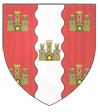 |
||||||||||
|
||||||||||||
 |
Guesnes |
| There was a double priory here dependent on
the Abbey of Fontevraud, now mostly in a ruinous state. The
monks' church was converted into the parish church of the
village but what remains of the nuns' quarters is now a private
house. The actual church of the latter is now an out-building in
a partly derelict condition. The two effigies lie under arches
at either side of the nave. At some point a substantial wall had
been built across the nave, dividing not only the nave itself
but also the monuments themselves in two. The upper part
of both effigies - the eastern part - has been almost totally
destroyed. Generally not accessible but occasionally open to the public. Park in village nearby. 46°54'57"N, 0°9'45"E |
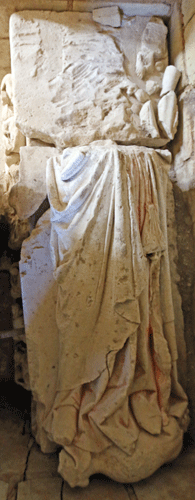 |
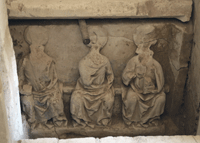 |
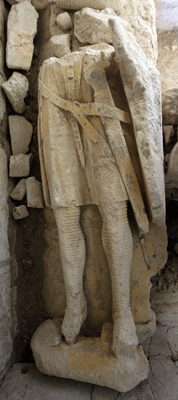 |
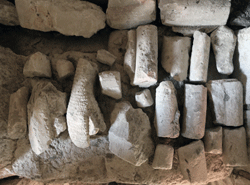 |
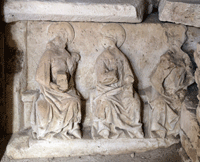 |
Far left: Effigy of a lady. Note the purse
attached to her belt and what looks like an animal (dog)
next to where the head used to be. It looks like a
second has been cut out from the opposite side. The
first is
shown at bottom of the next column and is an unusual as
normally angels support the pillow. Also shown are
figures on what remains of the tomb chest.
Left: Military effigy. Above are shown fragments including a mail gauntlet. |
||
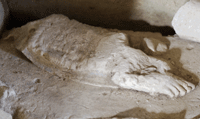 |
 |
Loudon - Church of St Peter du Marche |
 |
| The church is Eglise de St Pierre du
Marche not St Hilaire
de Martray, which is open infrequently. Church open; park in free car park 47˚ 0' 41" N; 0˚ 4' 40" W |
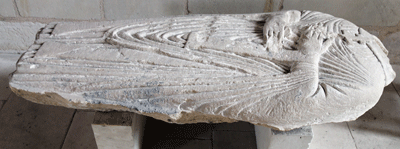 |
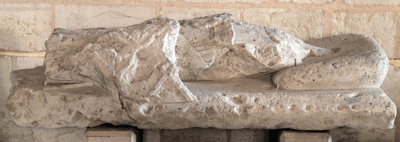 |
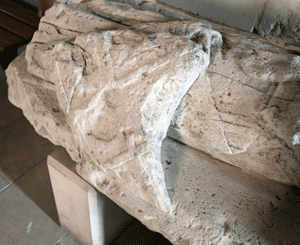 |
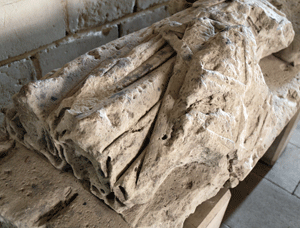 |
| Very damaged effigies of an unknown ecclesiastic | A military effigy of Fretard de Turzay | ||
| Morthemer |
| There is reported to be an effigy of Renée Sanglier, wife of Marthurn Taveau in the church but I have not visited it yet. |
 |
Rossay (near Loudun) Prieuré de Bois Rogue |
| This chapel is not usually open to the
public but is used for art exhibitions when it may be visited.
Park outside. 46°59'02"N, 0°08'36"W |
|
 |
|
| Effigy said to be of Gilles Sanglier c 1500) Inscription in Latin | |
| POITERS |
| Poitiers has a number of medieval churches but very few monuments. An interesting and attractive city to visit with plenty of car parks, some free |
 |
Ancien
Baptistère Saint-Jean Rue Jean Jurès |
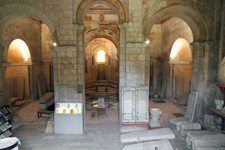 |
Entrance fee: €3.00. Photography allowed. Not open every day and closes for lunch; best to check website This is said to be the oldest Christian building in Western Europe |
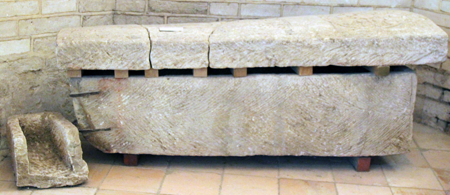 |
 |
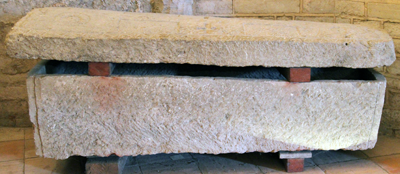 |
 |
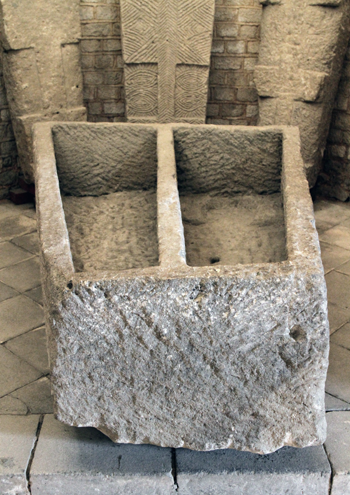 |
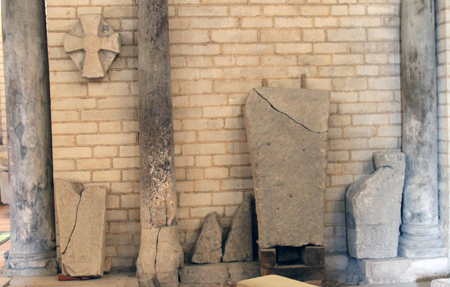 |
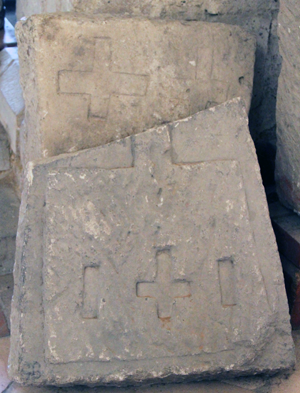 |
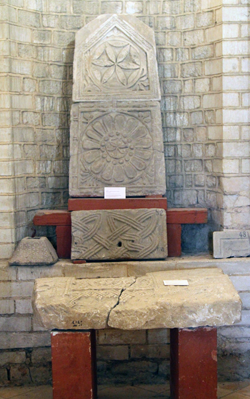 |
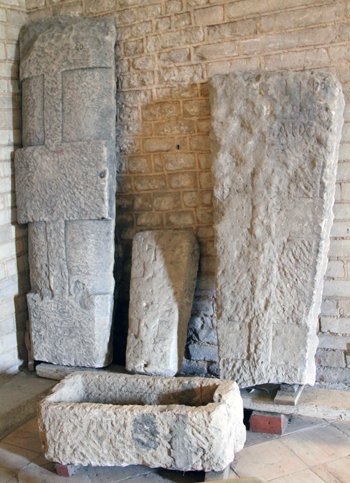 |
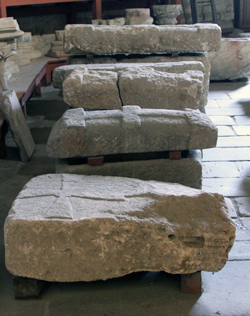 |
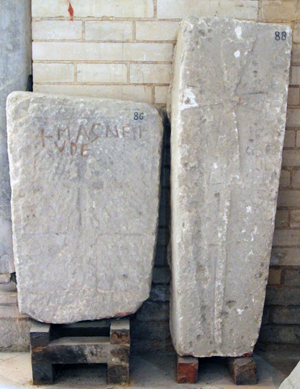 |
 |
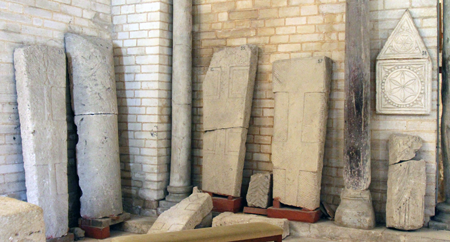 |
 |
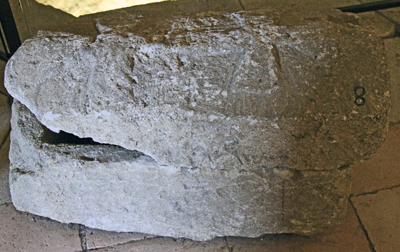 |
 |
 |
 |
The building dates from the 7th century (630-700); it is a rare example of a baptistery as well as of a Merovingian building preserved with its original facades. We now associate baptism with churches but originally the ceremony was carried out in a separate building adjacent to but not connected to the cathedral. This building began life as a baptistery where adults were baptsed by total immersion in a pool set into the ground in the central part of the building. During the Carolingian period baptisms began to be carried out in parish churches so the baptismal pool gradually became irrelevant; the baptistery was converted into the Church of St John the Baptist, the central pool being filled in, to be replaced by a central altar. The baptistery is not only now a museum of Merovingian stone but there are also very fine wall painting beginning from the end of the 11th century. The State bought the building in 1834 and handed it over to the local Society of Antiquaries in1836, who still manage it. The collection of sarcophagi is the work of Camille de la Croix and come from towns in Vienne including Poitiers itself, and date from the time of the baptistery (5th - 10th centuries). There are a number of designs on the lid which may be seen in the photographs and some lettering |
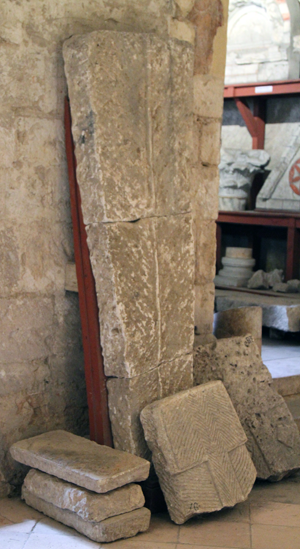 |
 |
Poiters Cathedral |
 |
| Just across from the
Baptistery. As usual in France, no charge, no restrictions on
photography, no refectory and no shop. The diocese of Poitiers was elevated to an archdiocese in 2002 so the monuments below are correctly to 19th century bishops |
 |
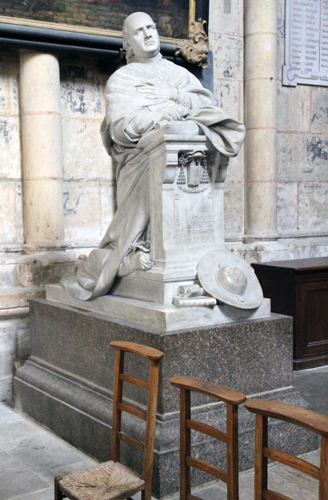 |
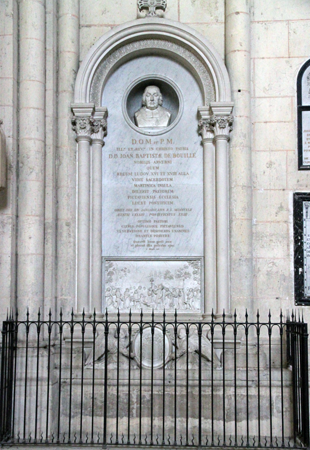 |
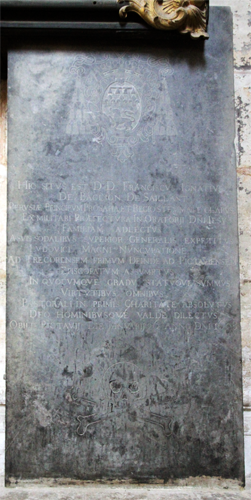 |
| Monuments of
Bishops of Poiters Left top: Joseph-Aimé Guitton (1849) Left bottom: Jean-Baptiste-Luc Bailly (1804) Top left: Cardinal Louis-François-Désiré-Edouard Pie (1880) Curiously his name does not appear on the monument but that of the sculptor is prominantly displayed on the left side of the base. Top centre: Jean-Baptiste de Bouillé (1842) Top right: François-Ignace de Baglion de Saillant (1698) This looks like the tomb stone of the late 17th century bishop now set against the wall with part of a heavy picture frame covering the upper part |
|||
| Ancienne Abbatiale Saint-Jean de
Montierneuf 29 Place Montierneuf |
| Built at the end of the 11th century by Guy-Geoffrey-William, 'The Eagle' 7th Duke of Aquitaine It was his burial place but all monuments and sites of interment were lost at the Revolution |
| At the moment (2019) the church is undergoing major construction work and although you may enter most of the building the monument to William, 7th Duke of Aquitaine - a cenotaph built in the 19th century - is covered by a wooden cage for protection and cannot be seen |
| ⁻¹ It appears his birth name was Guy-Geoffrey, the William being added when he became Duke of Aquitaine; he was already Duke of Gascony. The inheritance of the Duchies of Aquitaine, Gascony and County of Poitou is complicated as they do not necessarily follow each other so the numbers do not always correspond. Incidentally women had exceptionally good rights in this part of France during this period which they were not to gain again until the 20th century. Although geographically part of what we call France, this region was virtually independent. |